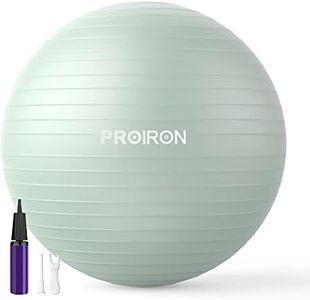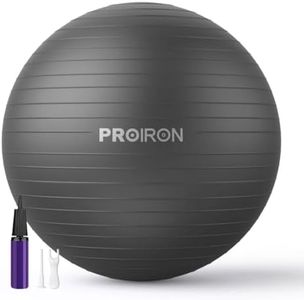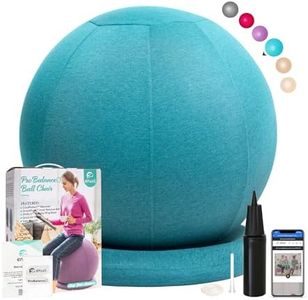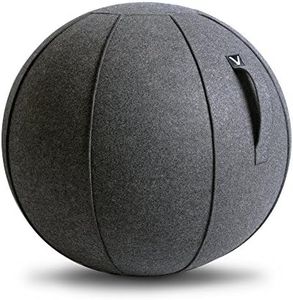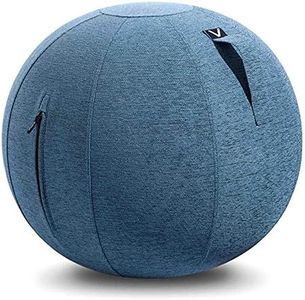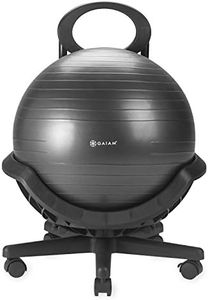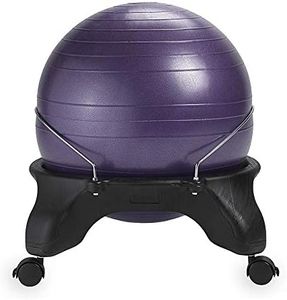We Use CookiesWe use cookies to enhance the security, performance,
functionality and for analytical and promotional activities. By continuing to browse this site you
are agreeing to our privacy policy
10 Best Ball Chairs
From leading brands and best sellers available on the web.Buying Guide for the Best Ball Chairs
Choosing a ball chair can be a fun and worthwhile investment for both comfort and posture. Ball chairs are often used as alternatives to traditional office chairs, aiming to promote better balance and engage your core muscles as you sit. The perfect ball chair can depend on a mix of personal comfort, intended use (such as for the office, home, or exercise), and safety. When shopping, think about how and where you plan to use the chair, how much movement you want, and your space limitations.Ball SizeBall size refers to the diameter of the ball that forms the seat of the chair. It’s important because it determines how your body aligns when seated, affecting both comfort and stability. Ball sizes commonly range from 45 cm to 75 cm in diameter. People under 5’4” usually feel comfortable with balls around 55 cm, while those between 5’4” and 6’0” might prefer a 65 cm ball, and taller people may benefit from 75 cm. The right size for you depends on your height: when you sit on the ball, your knees should be at a right angle and your feet flat on the floor. Measuring your leg length gives a good indication too. Always choose the size that lets you sit comfortably with good posture.
Weight CapacityWeight capacity is how much weight the ball chair can safely hold. This matters for both your safety and the lifespan of the chair. Weight limits can range from 200 lbs to 300 lbs or more. You should select a chair with a capacity that’s comfortably above your body weight, factoring in any extra items you might hold or wear while sitting. For extra reassurance or for shared environments, higher capacity is usually preferred.
Chair Base and StabilitySome ball chairs come with a fixed base or frame, while others are just the ball itself. A base enhances stability and prevents rolling, which can be helpful if you’re using the chair for long work sessions or if you prefer less movement. No base gives you a more active sitting experience but can take some getting used to. Think about whether you want more stability (base) or more core engagement and movement (no base)—this depends on your personal comfort and how dynamic you want your seating to be.
Back SupportCertain ball chairs include a backrest or some form of extra support, while others don’t. Back support can make the chair feel more like a traditional chair and may be helpful if you’re new to ball chairs, plan to sit for longer periods, or have back concerns. If you are comfortable with an upright, unsupported posture and want maximum core activation, you might choose a chair without a back; if you need extra support, look for one that has a built-in backrest.
Material QualityMaterial quality usually refers to the kind of PVC or rubber used for the ball and the sturdiness of any included frame. Good material improves durability, safety, and comfort. Higher quality balls tend to be thicker, burst-resistant, and more comfortable to sit on for long stretches. When comparing, look for 'anti-burst' or similar safety features. If you’ll use the chair frequently or share it among family or in an office, sturdier materials are preferable to prevent wear and tear.
Portability and StorageSome ball chairs are easy to deflate and store or have lightweight frames that can be moved around easily, while others are bulkier. If space is tight or you need to move the chair between rooms frequently, portability becomes essential. For stationary use, a heavier or more solid frame may work, but if you anticipate putting the chair away often or using it in different places, look for models that are easy to move and store.
